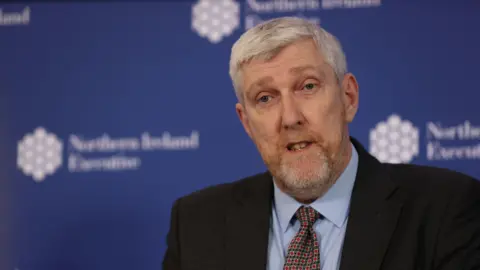What's next for NI after this week's Spending Review?
 PA Media
PA MediaWednesday's UK Spending Review means Stormont ministers now know the rough size of their budget in the two years before the next assembly election.
In 2026, they will have about £16.3bn for day-to-day spending, up by about 2% in cash terms compared to this year.
That will initially rise by another 3% in cash terms in 2027 to £16.8bn.
Finance Minister John O'Dowd did not waste any time in managing expectations about what this means.
"The reality is the executive will still remain in a financially constrained position, particularly in 2026-27," he said.
"It is clear that significant challenges remain for our public services."
Those challenges were obvious on the streets of Northern Ireland this week.
The Police Service of Northern Ireland (PSNI), which the chief constable says is "critically underfunded", had to ask for outside help after just two nights of violence.
 PA Media
PA MediaJustice Minister Naomi Long is bidding for funding for a policing recovery plan, which is one of many competing priorities.
Earlier in the week, the independent budget watchdog, the NI Fiscal Council, warned there were no easy answers to the chronic underfunding of NI Water.
A lack of investment in wastewater infrastructure is already undermining other executive aims to increase housing supply and tackle pollution.
A 'needs-based' top-up for Stormont
The Spending Review confirmed that for the foreseeable future Stormont will continue to get a "needs-based" financial top-up.
It was introduced when devolution returned last year and adds 24p to every £1 which comes to Northern Ireland via the standard devolution funding formula.
A bid to increase the size of the top-up was not successful, though negotiations between Stormont and the Treasury continue.
So with no immediate prospect of significant additional funds from London executive ministers will need to look again at how they spend what they have.
A more stable Stormont means makes a strategic approach relatively easier.
The intention is to use the Spending Review as an opportunity to agree a multi-year budget next year, the first time that will have happened in more than a decade.
 Reuters
ReutersThe Audit Office, a spending watchdog, has previously concluded that single-year budgets were hampering planning and innovation across NI public services.
"The executive now needs to move away from single-year, crisis budgets and take more ownership of its own financial position," said Ann Watt, director of the Pivotal think tank.
"A multi-year settlement provides a chance for ministers to plan for the next three years, and choose how best to prioritise spending, investment, reform and workforce planning."
However she warned that a multi-year budget on its own will come nowhere near to solving the problems in NI public services.
"Transformation is essential," she said.
"This is the only way that services can be made sustainable and affordable for now and the future.
"A focus on prevention and early intervention is key."
Some relative minor transformation projects are underway, funded by the financial package which accompanied the return of devolution.
There is probably only a limited window to start bolder, perhaps controversial, projects before the Stormont parties start to move into election mode in the second half of next year.
